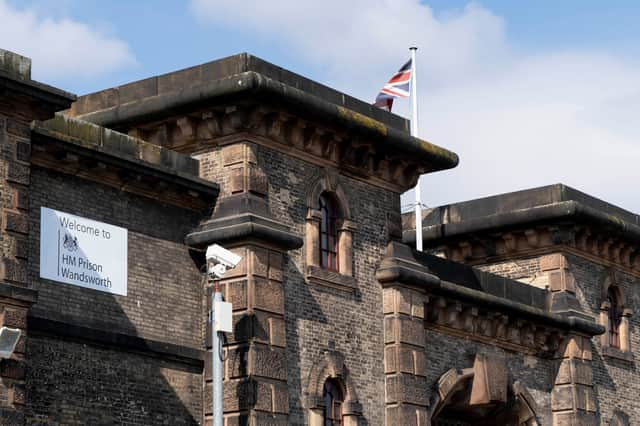Where is Wandsworth? Prison history after Daniel Khalife escape, notable inmates - have people escaped before?


The jail from which former soldier Daniel Khalife escaped “really needs closing”, the prisons watchdog said. Chief Inspector of Prisons Charlie Taylor said “in an ideal world” Wandsworth would be shut, but “there are only just enough prisons” for the population of inmates.
Wandsworth prison’s performance was rated a “serious concern” and watchdogs had issued a string of warnings about the jail in the past year before Khalife escaped.
Advertisement
Hide AdAdvertisement
Hide AdThe category B reception and resettlement men’s prison, which opened in 1851, is one of only nine jails out of 119 in England and Wales whose performance has been called into question recently.
Governor Katie Price presides over the Victorian jail, which holds about 1,600 defendants appearing at Londoncourts and offenders due to be released, in five wings.
Taylor told Politics Hub with Sophy Ridge on Sky News: “When you find a prison like Wandsworth, it really needs closing. Ultimately, it’s not a suitable prison.”
But what exactly is the history of Wandsworth Prison, where is it located, and have there been previous escape attempts?
Advertisement
Hide AdAdvertisement
Hide AdWhere is Wandsworth Prison?
Wandsworth Prison is situated in the Borough of Wandsworth in the southwest part of London.
Wandsworth is situated along the south bank of the River Thames, and is bordered by several other London boroughs, including Lambeth, Merton, Richmond upon Thames, and Kingston upon Thames
It is known for its diverse neighbourhoods, green spaces, and various amenities, and is well-connected to the rest of London through public transportation, including the London Underground and various bus routes.
What is the history of Wandsworth Prison?
Wandsworth Prison was built in the mid-19th century and officially opened in 1851. It was designed by the English architect William Blackburn, and was constructed to serve as a Category B/C men's prison.
Advertisement
Hide AdAdvertisement
Hide AdDuring the Victorian era, Wandsworth was known for its harsh and strict conditions, which were typical of many prisons during that time. It housed both male and female prisoners and had a reputation for tough discipline.
The prison played a role in World War II as it was used to hold enemy aliens and political prisoners, including some inmates who were foreign nationals suspected of having Nazi sympathies.
In more recent times, Wandsworth Prison has continued to operate as a men's prison, housing inmates serving various sentences, including both short-term and long-term sentences. It has also been used to hold remand prisoners awaiting trial.
Like many older prisons, Wandsworth has faced criticism for its conditions, overcrowding, and challenges in rehabilitation. Efforts have been made to improve conditions and provide support for prisoners' reintegration into society.
Advertisement
Hide AdAdvertisement
Hide AdToday, Wandsworth Prison is a Category B prison, and one of the largest and oldest prisons in London. UK prisons are categorised into different security levels, ranging from Category A (the highest security level) to Category D (the lowest security level).
Category B prisons are typically for prisoners who do not require maximum security but still need a high level of security and control.
In the 2010s, there were discussions about the need for refurbishment and modernisation of Wandsworth Prison to address its ageing infrastructure and improve the living conditions for inmates.
Have there been any notorious inmates?
Wandsworth Prison has housed several infamous, famous or notorious inmates over the years, including famous Irish playwright and author Oscar Wilde.
Advertisement
Hide AdAdvertisement
Hide AdWilde was imprisoned at Wandsworth in 1895 for "gross indecency", and his imprisonment and subsequent time in Wandsworth had a significant impact on his life and literary work.
John George Haigh - a serial killer who murdered several people in the 1940s and disposed of their bodies in acid - was held at Wandsworth Prison before his execution in 1949, and Charles Bronson (now known as Charles Salvador) was held at Wandsworth at different times for various offences.
Have there ever been any attempts to break out before?
There have been breakout attempts and escape incidents at Wandsworth Prison, as is the case with many prisons around the world. While some attempts have been successful, others were thwarted.
Perhaps one of the most famous escape attempts in the history of Wandsworth Prison was carried out by Ronnie Biggs in 1965. Biggs was a member of the gang that executed the Great Train Robbery in 1963.
Advertisement
Hide AdAdvertisement
Hide AdHe was sentenced to 30 years in prison but managed to escape from Wandsworth Prison in July 1965 by scaling the prison wall using a rope ladder.
Biggs' escape led to a decades-long international manhunt, during which he lived in various countries before eventually returning to the UK in 2001 and voluntarily surrendering to authorities.
In 1995, James Moody, a convicted armed robber, made a daring escape from Wandsworth Prison. He also used a makeshift rope ladder to scale the prison walls and then fled the scene. His escape led to a nationwide manhunt, and he remained on the run for several weeks before being recaptured and returned to prison.
And in 2019, an unnamed inmate escaped from Wandsworth by using essentially the same methods as Daniel Khalife. Returning to the prison after a visit to court, the prisoner is said to have also escaped by latching onto the underside of a vehicle.
Advertisement
Hide AdAdvertisement
Hide AdThe van was inspected before leaving Wandsworth, however officers were unsuccessful in spotting the prisoner via their mirrors. The prison was placed under lockdown and the inmate was eventually caught.
Comment Guidelines
National World encourages reader discussion on our stories. User feedback, insights and back-and-forth exchanges add a rich layer of context to reporting. Please review our Community Guidelines before commenting.
